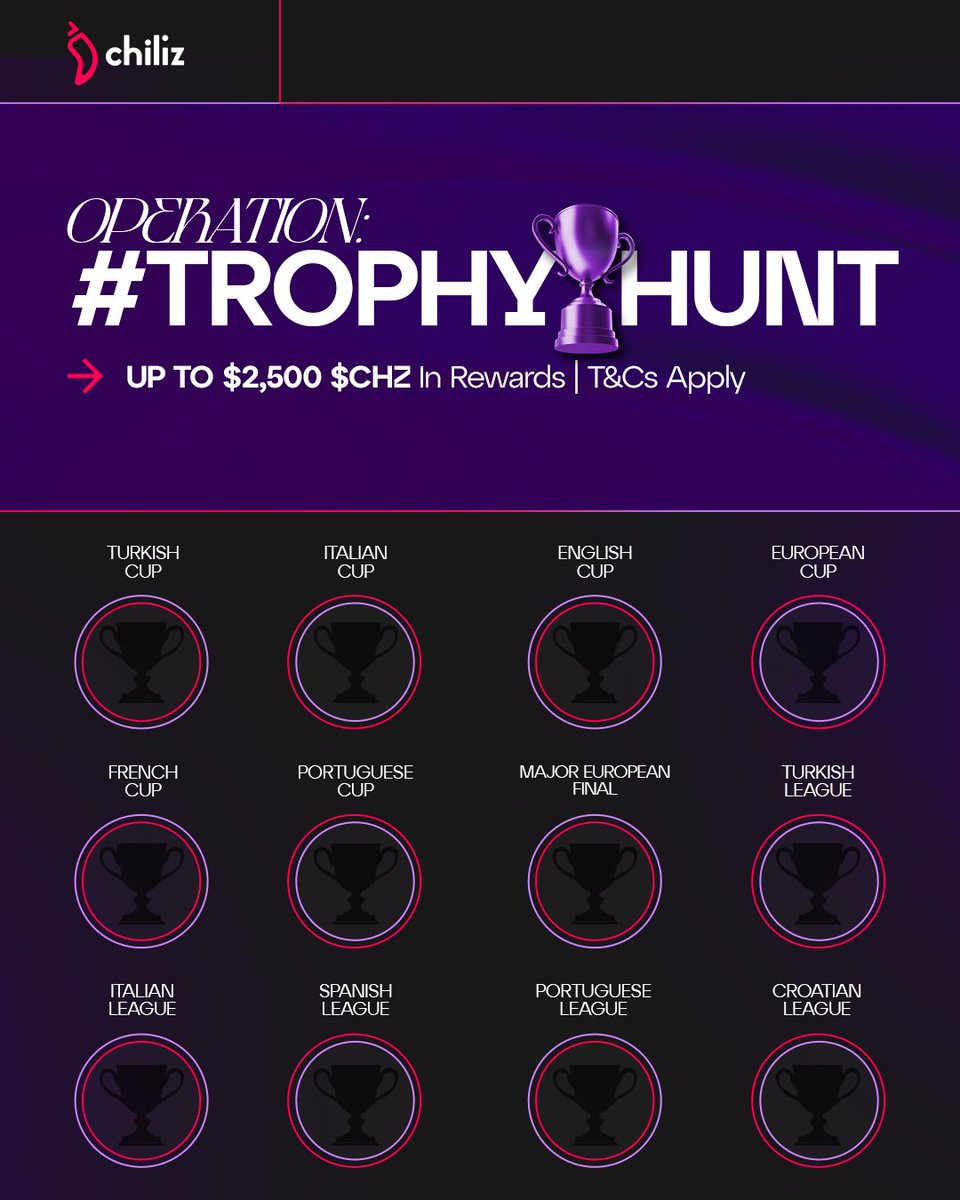
CHZ
Chiliz koers
$0,042840
-$0,00219
(-4,87%)
Prijsverandering voor de afgelopen 24 uur

Wat vind je vandaag van CHZ?
Deel je mening hier door een duim omhoog te geven als je je bullish voelt over een munt of een duim omlaag als je je bearish voelt.
Stem om resultaten te bekijken
Disclaimer
De sociale inhoud op deze pagina ("Inhoud"), inclusief maar niet beperkt tot tweets en statistieken die door LunarCrush worden verstrekt, is afkomstig van derden en wordt alleen voor informatieve doeleinden geleverd "zoals deze is". OKX geeft geen garantie voor de kwaliteit of nauwkeurigheid van de Inhoud en de Inhoud vertegenwoordigt niet de standpunten van OKX. Het is niet bedoeld om (i) beleggingsadvies of een beleggingsaanbeveling te geven; (ii) een aanbod of verzoek om digitale bezitting te kopen, verkopen of te bezitten; of (iii) financieel, boekhoudkundig, juridisch of fiscaal advies. Digitale bezittingen, waaronder stablecoins en NFT's, brengt een hoog risico met zich mee en kan sterk fluctueren. De prijs en prestaties van de digitale bezittingen zijn niet gegarandeerd en kunnen zonder voorafgaande kennisgeving worden gewijzigd.<br></br>OKX geeft geen beleggings- of vermogensadvies. Je moet zorgvuldig overwegen of het verhandelen of bezitten van digitale bezittingen voor jou geschikt is in het licht van je financiële toestand. Raadpleeg je juridische, fiscale of beleggingsadviseur als je vragen hebt over je specifieke situatie. Raadpleeg voor meer informatie onze <a href="/help/terms-of-service">Gebruiksvoorwaarden</a> en <a href="/help/risk-compliance-disclosure">Risicowaarschuwing</a>. Door gebruik te maken van de website van derden ('TPW'), ga je ermee akkoord dat elk gebruik van de TPW onderworpen is aan en beheerst wordt door de voorwaarden van de TPW. Tenzij uitdrukkelijk schriftelijk vermeld, zijn OKX en haar partners ("OKX") op geen enkele manier verbonden met de eigenaar van de exploitant van de TPW. Je gaat ermee akkoord dat OKX niet verantwoordelijk of aansprakelijk is voor verlies, schade en andere gevolgen die voortvloeien uit jouw gebruik van de TPW. Houd er rekening mee dat het gebruik van een TPW kan leiden tot verlies of vermindering van je bezittingen. Het product is mogelijk niet in alle rechtsgebieden beschikbaar.
Chiliz marktinformatie
Marktkapitalisatie
Marktkapitalisatie wordt berekend door het circulerende aanbod van een munt te vermenigvuldigen met de laatste prijs.
Marktkapitalisatie = Circulerend aanbod × Laatste prijs
Marktkapitalisatie = Circulerend aanbod × Laatste prijs
Circulerend aanbod
Totale bedrag van een munt dat openbaar beschikbaar is op de markt.
Positie marktkapitalisatie
De positie van een munt in termen van marktkapitalisatie.
Historisch hoogtepunt
Hoogste prijs die een munt heeft bereikt in zijn handelsgeschiedenis.
Historisch dieptepunt
Laagste prijs die een munt heeft bereikt in zijn handelsgeschiedenis.
Marktkapitalisatie
$412,38M
Circulerend aanbod
9.599.168.751 CHZ
100,00% van
9.599.168.751 CHZ
Positie marktkapitalisatie
94
Audits

Laatste audit: 18 okt 2023
24u hoog
$0,045670
24u laag
$0,042350
Historisch hoogtepunt
$0,94489
-95,47% (-$0,90205)
Laatste update: 13 mrt 2021
Historisch dieptepunt
$0,034440
+24,39% (+$0,0084000)
Laatste update: 9 apr 2025
Chiliz Feed
De volgende inhoud is afkomstig van .

小捕手 Chaos heeft opnieuw gepost

小捕手 Chaos
Jij veegt Binance alpha, ik veeg Virtuals-punten. We hebben allemaal een mooie toekomst voor ons.
@arbusai $ARBUS is in 5 uur voorbij en ik raad het head-by-head aan. Persoonlijk heb ik het gevoel dat het 50x basis zal zijn.
Positionering van het project:
Een AI-marktinformatielaag die data-intelligentiediensten levert voor InfoFi en de bureau-economie.
Medewerkers:
Chiliz
LunarCrush
derde web
Stichting COTI
Giza
Wachten.
Redenen voor optimisme:
(1) De duur van de oefening is twee en een half jaar en is sinds 2022 vastgesteld
(2) Teamleden van bekende technologiebedrijven zoals Chiliz, Vodafone, Google en Amazon (naar schatting zijn het geen kernleden, maar gewone werknemers, anders waren ze al lang opgejaagd)
(3) Het vlaggenschipproduct Arbus Terminal is gelanceerd, met 500+ maandelijkse actieve gebruikers (officiële gegevens op zich openbaar, geen opscheppen, dus eerlijk)
(4) L1-financiering uit de top 20 (waarvan L1 niet bekend wordt gemaakt)
In wezen gaat het om ongeveer 10 miljoen FDV.


toffee
Van signaal tot uitvoering: hoe @arbusai de InfoFi Supercycle van stroom voorziet met @virtuals_io
Arbus bouwen: de intelligentielaag voor de agentische economie
Sinds 2022 zijn we stilletjes maar meedogenloos bezig met het bouwen van Arbus, de AI-marktinformatielaag die is ontworpen om slimmere coördinatie in de InfoFi- en agentische economie te ondersteunen.
In de afgelopen 2,5 jaar zijn we verder gegaan dan prototypes en hebben we een productieproduct geleverd: Arbus Terminal, ons vlaggenschip intelligentieplatform dat al in gebruik is door 500+ maandelijkse actieve gebruikers.
Arbus zet gefragmenteerde, ruisrijke marktsignalen om in gestructureerde, realtime inzichten, die onderzoek, vroege ontdekking, narratieve analyse en platformonafhankelijke intelligentie voor zowel mensen als AI-agenten mogelijk maken.
Gesteund door subsidies en steun van leiders zoals @LunarCrush, @thirdweb en @COTInetwork, en in samenwerking met innovators zoals @Chiliz, @gizatechxyz en @zero1_labs, is Arbus nu geïntegreerd in een groeiend Web3-ecosysteem.
En we zijn nog maar net begonnen. Met Arbus Agent en het Data Collection Network die binnenkort live gaan, zal de Arbus-intelligentielaag zich uitbreiden naar autonoom onderzoek, gamified databijdrage en een gedecentraliseerde marktplaats voor gestructureerde inzichten.
⸻
Waarom InfoFi, waarom nu: een nieuw tijdperk van programmeerbare aandacht
De opkomst van InfoFi signaleert een verschuiving waarbij informatie zelf een financieel bezit wordt, niet alleen gegevens, maar ook verhalen, context en aandacht.
In dit nieuwe landschap zorgt intelligentie voor waarde. En Arbus is speciaal gebouwd om in deze omgeving te werken.
Een van de meest kritische elementen van deze verschuiving is mindshare, de mate van publieke aandacht en narratieve zwaartekracht die een project afdwingt.
In Web3, waar de marktperceptie sneller beweegt dan de fundamentals, is mindshare vaak het eerste en belangrijkste signaal van waardecreatie.
Bij Arbus kwantificeren en volgen we mindshare over duizenden projecten. Dit geeft gebruikers en ontwikkelaars de mogelijkheid om trends te identificeren, sentiment te peilen en te begrijpen hoe verhalen evolueren, voordat ze viraal gaan.
Dat is de basis van onze gestructureerde intelligentie-infrastructuur en waarom we geloven dat InfoFi de volgende Web3-cyclus zal definiëren.
⸻
Waarom we lanceren op @virtuals_io : Een natuurlijke pasvorm voor Arbus
Na het evalueren van meerdere paden naar de markt, kozen we Virtuals Protocol als onze lanceringspartner, niet alleen vanwege hun tractie, maar ook omdat hun missie aansluit bij de onze. Dit is wat opviel:
1. Speciaal gebouwd voor de agentische economie
Virtuals is een pionier op het gebied van infrastructuur voor AI-native coördinatie, van intentie tot afwikkeling.
Hun Agent Commerce Protocol (ACP) stelt autonome agenten in staat om te handelen op basis van realtime gegevens, en Arbus zal rechtstreeks in deze stroom worden ingebed als de intelligentielaag.
2. Echte gemeenschap, echte overtuiging
Virtuals heeft een van de meest betrokken ecosystemen in Web3 gebouwd en beloont gebruikers voor zinvolle deelname, niet alleen voor speculatie.
Programma's zoals Yapping Points, Trencher Points en de Diamond Hand Bonus weerspiegelen een systeem dat is ontworpen voor geloof op de lange termijn, niet voor pompen op korte termijn.
3. Bouwer-DNA en snelle iteratie
Het Virtuals-team heeft consequent bewezen dat het in staat is om snel te verzenden, problemen proactief op te lossen en het platform te ontwikkelen op basis van echte feedback.
Van het oplossen van sniping-problemen tot het upgraden van hun governancetools en ecosysteem-UX, ze belichamen het soort snelheid en reactievermogen dat we zeer waarderen.
4. Een lanceervliegwiel dat werkt
Het nieuwe lanceringsmodel van Virtuals heeft al resultaten opgeleverd, met sterke on-chain prestaties, succesvolle tokenlanceringen en een toenemende vraag die terugvloeit naar het ecosysteem.
Voor een project als Arbus, dat op de intelligentielaag opereert, is deze feedbacklus essentieel voor distributie en bruikbaarheid.
⸻
Wat is het volgende
Nu Arbus Terminal live is en is geïntegreerd in workflows in de hele ruimte, bereiden we ons voor op de volgende groeifase:
• Arbus Agent, onze autonome AI KOL, komt eraan
• Data Collection Network, een gamified contributor engine, zal volgen
• De Data Marketplace en Agentic DAO staan op de roadmap voor 2025
En het begint allemaal met onze lancering op Virtuals Protocol, een platform dat onze waarden, onze snelheid en onze overtuiging deelt dat de toekomst toebehoort aan intelligente systemen die zijn gebouwd op verifieerbare gegevens.
19,17K
43

Chiliz - The Sports Blockchain
Binnenkomend bericht 📬
NAAR: Web3 & dApp Ontwikkelaars | Makers van inhoud | Veiligheidsauditors | Beïnvloeders | (UI/UX) Ontwerpers | Knooppunt-operators | Ontwikkelaars van slimme contracten | NFT-makers | QA/DeFi-analisten | Beheerders van de gemeenschap
CC: Alle Chilizens
Betreft: WAT IS CHILIZ GREENHOUSE? ⬇️🧵
Origineel weergeven
30,15K
52

Chiliz - The Sports Blockchain
🏆 KAMPIOENEN! 🏆
$BAR de trofee in de wacht sleepten, zijn $BAR landskampioen!
operatie: #TrophyHunt gaat goed.
Visca el Barça, Visca $BAR! 🔵🔴


Chiliz - The Sports Blockchain
12 kansen. 12 trofeeën om in de wacht te slepen.
Tot $ 2.500 aan $CHZ voor het grijpen.
Dit is Bediening: #TrophyHunt 🏆
Laten we ze allemaal verzamelen.

13,69K
37
CHZ-calculator


Chiliz prijsprestatie in USD
De huidige koers van Chiliz is $0,042840. Gedurende de afgelopen 24 uur, Chiliz is met afgenomen tegen -4,86%. Het heeft momenteel een circulerend aanbod van 9.599.168.751 CHZ en een maximaal aanbod van 9.599.168.751 CHZ, waardoor het een volledig verwaterde marktkapitalisatie van $412,38M heeft. Op dit moment bezit de Chiliz-munt, de 94 positie in de marktkapitalisatie positie. De Chiliz/USD-prijs wordt in real time geüpdatet.
Vandaag
-$0,00219
-4,87%
7 dagen
-$0,00466
-9,82%
30 dagen
+$0,0069800
+19,46%
3 maanden
-$0,01701
-28,43%
Populaire Chiliz-conversies
Laatste update: 17-05-2025, 16:24
| 1 CHZ tot USD | $ 0,042960 |
| 1 CHZ tot EUR | € 0,038487 |
| 1 CHZ tot PHP | ₱ 2,3973 |
| 1 CHZ tot IDR | Rp 708,56 |
| 1 CHZ tot GBP | £ 0,032342 |
| 1 CHZ tot CAD | $ 0,060017 |
| 1 CHZ tot AED | AED 0,15779 |
| 1 CHZ tot VND | ₫ 1.113,53 |
Over Chiliz (CHZ)
De beoordeling is een algehele waardering die OKX verzamelt vanaf verschillende bronnen en is alleen bestemd voor intern gebruik. OKX geeft geen garantie wat betreft de kwaliteit of de nauwkeurigheid van een beoordeling. Deze is niet bedoeld als (i) beleggingsadvies of -aanbeveling, (ii) een aanbod voor of verzoek om digitale activa te kopen, te verkopen of aan te houden, of (iii) advies op het gebied van financiën, boekhouding of belastingen. Digitale activa, waaronder stablecoins en NFT's, brengen aanzienlijke risico’s met zich mee. Ze kunnen sterk fluctueren in waarde of zelfs waardeloos worden. De prijzen en bewegingen van digitale activa zijn onvoorspelbaar en kunnen zomaar veranderen. Je digitale activa zijn niet verzekerd tegen mogelijke verliezen. In het verleden behaalde resultaten bieden geen garantie voor de toekomst. OKX garandeert geen terugbetaling van de hoofdsom of rente. OKX geeft geen aanbevelingen voor investeringen of activa. Voordat je besluit om digitale activa te verhandelen of aan te houden, moet je zorgvuldig analyseren of jouw financiële situatie dit toelaat. Raadpleeg bij vragen hierover altijd een juridisch, fiscaal of beleggingsadviseur.
Verder lezen
- Officiële website
- Whitepaper
- Blokverkenner
Informatie over websites van derden
Informatie over websites van derden
Door de website van derden ('TPW') te gebruiken, aanvaard je dat elk gebruik van de TPW onderworpen is aan en geregeld wordt door de voorwaarden van de TPW. Tenzij uitdrukkelijk schriftelijk vermeld, zijn OKX en haar partners ('OKX') op geen enkele wijze verbonden met de eigenaar of exploitant van de TPW. Je stemt ermee in dat OKX niet verantwoordelijk of aansprakelijk is voor verlies, schade en andere gevolgen die voortvloeien uit je gebruik van de TPW. Houd er rekening mee dat het gebruik van een TPW kan leiden tot verlies of waardevermindering van je bezittingen.
Chiliz Veelgestelde vragen
Hoe veel is één Chiliz vandaag waard?
Momenteel is één Chiliz de waarde van $0,042840. Voor antwoorden en inzicht in de prijsactie van Chiliz ben je op de juiste plek. Ontdek de nieuwste Chiliz grafieken en handel verantwoord met OKX.
Wat is cryptocurrency?
Cryptocurrency's, zoals Chiliz, zijn digitale bezittingen die op een openbaar grootboek genaamd blockchains werken. Voor meer informatie over munten en tokens die op OKX worden aangeboden en hun verschillende kenmerken, inclusief live-prijzen en grafieken in real time.
Wanneer zijn cryptocurrency's uitgevonden?
Dankzij de financiële crisis van 2008 nam de belangstelling voor gedecentraliseerde financiën toe. Bitcoin bood een nieuwe oplossing door een veilige digitale bezitting te zijn op een gedecentraliseerd netwerk. Sindsdien zijn er ook veel andere tokens zoals Chiliz aangemaakt.
Zal de prijs van Chiliz vandaag stijgen?
Bekijk onze Chiliz Prijsvoorspellingspagina om toekomstige prijzen te voorspellen en je prijsdoelen te bepalen.
ESG-vermelding
ESG-regelgeving (Environmental, Social, and Governance) voor crypto-bezit is gericht op het aanpakken van hun milieu-impact (bijv. energie-intensieve mining), het bevorderen van transparantie en het waarborgen van ethische bestuurspraktijken om de crypto-industrie op één lijn te brengen met bredere duurzaamheids- en maatschappelijke doelen. Deze regels stimuleren de naleving van normen die risico's beperken en het vertrouwen in digitale bezitting bevorderen.
Details bezittingen
Naam
OKcoin Europe LTD
Identificatiecode relevante juridische entiteit
54930069NLWEIGLHXU42
Naam van het crypto-bezit
Chiliz
Consensusmechanisme
Chiliz is present on the following networks: binance_beacon_chain, chiliz, chiliz_2, ethereum, solana.
Binance Beacon Chain operated on a Delegated Proof of Stake (DPoS) consensus mechanism before its operations were discontinued in fall 2024 and its migration to Binance Smart Chain; validators were elected by token holders through staking and voting, limiting active participation to a manageable number of nodes while maintaining decentralization; validators were selected based on the staking weight of their delegators, ensuring stakeholder interests were proportionally represented in the validation process; regular validator rotation was implemented to promote fairness and decentralization by allowing multiple participants to contribute to the network; the system was designed to tolerate some degree of validator failures while maintaining the network’s operational integrity, ensuring resilience.
The Chiliz Chain operates on a Proof of Staked Authority (PoSA) consensus model, a hybrid that combines Proof of Stake (PoS) and Proof of Authority (PoA) to secure the network through both economic and reputational incentives. Core Components: Proof of Staked Authority (PoSA) Validator Selection: Validators are selected based on their stake of CHZ tokens and their reputation within the network, enhancing security and trustworthiness. Collateral Requirement: Validators must lock a portion of CHZ as collateral, which can be slashed if they act maliciously or fail to meet network standards, ensuring alignment with network security.
The Ethereum network uses a Proof-of-Stake Consensus Mechanism to validate new transactions on the blockchain. Core Components 1. Validators: Validators are responsible for proposing and validating new blocks. To become a validator, a user must deposit (stake) 32 ETH into a smart contract. This stake acts as collateral and can be slashed if the validator behaves dishonestly. 2. Beacon Chain: The Beacon Chain is the backbone of Ethereum 2.0. It coordinates the network of validators and manages the consensus protocol. It is responsible for creating new blocks, organizing validators into committees, and implementing the finality of blocks. Consensus Process 1. Block Proposal: Validators are chosen randomly to propose new blocks. This selection is based on a weighted random function (WRF), where the weight is determined by the amount of ETH staked. 2. Attestation: Validators not proposing a block participate in attestation. They attest to the validity of the proposed block by voting for it. Attestations are then aggregated to form a single proof of the block’s validity. 3. Committees: Validators are organized into committees to streamline the validation process. Each committee is responsible for validating blocks within a specific shard or the Beacon Chain itself. This ensures decentralization and security, as a smaller group of validators can quickly reach consensus. 4. Finality: Ethereum 2.0 uses a mechanism called Casper FFG (Friendly Finality Gadget) to achieve finality. Finality means that a block and its transactions are considered irreversible and confirmed. Validators vote on the finality of blocks, and once a supermajority is reached, the block is finalized. 5. Incentives and Penalties: Validators earn rewards for participating in the network, including proposing blocks and attesting to their validity. Conversely, validators can be penalized (slashed) for malicious behavior, such as double-signing or being offline for extended periods. This ensures honest participation and network security.
Solana uses a unique combination of Proof of History (PoH) and Proof of Stake (PoS) to achieve high throughput, low latency, and robust security. Here’s a detailed explanation of how these mechanisms work: Core Concepts 1. Proof of History (PoH): Time-Stamped Transactions: PoH is a cryptographic technique that timestamps transactions, creating a historical record that proves that an event has occurred at a specific moment in time. Verifiable Delay Function: PoH uses a Verifiable Delay Function (VDF) to generate a unique hash that includes the transaction and the time it was processed. This sequence of hashes provides a verifiable order of events, enabling the network to efficiently agree on the sequence of transactions. 2. Proof of Stake (PoS): Validator Selection: Validators are chosen to produce new blocks based on the number of SOL tokens they have staked. The more tokens staked, the higher the chance of being selected to validate transactions and produce new blocks. Delegation: Token holders can delegate their SOL tokens to validators, earning rewards proportional to their stake while enhancing the network's security. Consensus Process 1. Transaction Validation: Transactions are broadcast to the network and collected by validators. Each transaction is validated to ensure it meets the network’s criteria, such as having correct signatures and sufficient funds. 2. PoH Sequence Generation: A validator generates a sequence of hashes using PoH, each containing a timestamp and the previous hash. This process creates a historical record of transactions, establishing a cryptographic clock for the network. 3. Block Production: The network uses PoS to select a leader validator based on their stake. The leader is responsible for bundling the validated transactions into a block. The leader validator uses the PoH sequence to order transactions within the block, ensuring that all transactions are processed in the correct order. 4. Consensus and Finalization: Other validators verify the block produced by the leader validator. They check the correctness of the PoH sequence and validate the transactions within the block. Once the block is verified, it is added to the blockchain. Validators sign off on the block, and it is considered finalized. Security and Economic Incentives 1. Incentives for Validators: Block Rewards: Validators earn rewards for producing and validating blocks. These rewards are distributed in SOL tokens and are proportional to the validator’s stake and performance. Transaction Fees: Validators also earn transaction fees from the transactions included in the blocks they produce. These fees provide an additional incentive for validators to process transactions efficiently. 2. Security: Staking: Validators must stake SOL tokens to participate in the consensus process. This staking acts as collateral, incentivizing validators to act honestly. If a validator behaves maliciously or fails to perform, they risk losing their staked tokens. Delegated Staking: Token holders can delegate their SOL tokens to validators, enhancing network security and decentralization. Delegators share in the rewards and are incentivized to choose reliable validators. 3. Economic Penalties: Slashing: Validators can be penalized for malicious behavior, such as double-signing or producing invalid blocks. This penalty, known as slashing, results in the loss of a portion of the staked tokens, discouraging dishonest actions.
Stimuleringsmechanismen en toepasselijke vergoedingen
Chiliz is present on the following networks: binance_beacon_chain, chiliz, chiliz_2, ethereum, solana.
The Binance Beacon Chain incentivized validators and ensured fee transparency before its migration to Binance Smart Chain; validators were rewarded solely through transaction fees, with no block rewards provided, aligning incentives with network usage and transaction volume; transaction fees were calculated and displayed upfront, ensuring clarity for users and promoting trust in the fee structure; a portion of transaction fees collected in BNB was burned, reducing the overall token supply and contributing to a deflationary economic model.
Chiliz incentivizes validators and delegators to contribute to network security through rewards and transaction fees in CHZ. Incentive Mechanisms: Staking Rewards Validator Rewards: Validators earn CHZ tokens for validating transactions and maintaining network integrity. Delegator Rewards: CHZ holders who delegate their tokens to validators share in staking rewards, allowing passive participation in network security. Applicable Fees: Transaction Fees CHZ-Based Fees: Transaction fees are paid in CHZ and are distributed to validators as additional compensation, supporting validator incentives and covering network operational costs.
Ethereum, particularly after transitioning to Ethereum 2.0 (Eth2), employs a Proof-of-Stake (PoS) consensus mechanism to secure its network. The incentives for validators and the fee structures play crucial roles in maintaining the security and efficiency of the blockchain. Incentive Mechanisms 1. Staking Rewards: Validator Rewards: Validators are essential to the PoS mechanism. They are responsible for proposing and validating new blocks. To participate, they must stake a minimum of 32 ETH. In return, they earn rewards for their contributions, which are paid out in ETH. These rewards are a combination of newly minted ETH and transaction fees from the blocks they validate. Reward Rate: The reward rate for validators is dynamic and depends on the total amount of ETH staked in the network. The more ETH staked, the lower the individual reward rate, and vice versa. This is designed to balance the network's security and the incentive to participate. 2. Transaction Fees: Base Fee: After the implementation of Ethereum Improvement Proposal (EIP) 1559, the transaction fee model changed to include a base fee that is burned (i.e., removed from circulation). This base fee adjusts dynamically based on network demand, aiming to stabilize transaction fees and reduce volatility. Priority Fee (Tip): Users can also include a priority fee (tip) to incentivize validators to include their transactions more quickly. This fee goes directly to the validators, providing them with an additional incentive to process transactions efficiently. 3. Penalties for Malicious Behavior: Slashing: Validators face penalties (slashing) if they engage in malicious behavior, such as double-signing or validating incorrect information. Slashing results in the loss of a portion of their staked ETH, discouraging bad actors and ensuring that validators act in the network's best interest. Inactivity Penalties: Validators also face penalties for prolonged inactivity. This ensures that validators remain active and engaged in maintaining the network's security and operation. Fees Applicable on the Ethereum Blockchain 1. Gas Fees: Calculation: Gas fees are calculated based on the computational complexity of transactions and smart contract executions. Each operation on the Ethereum Virtual Machine (EVM) has an associated gas cost. Dynamic Adjustment: The base fee introduced by EIP-1559 dynamically adjusts according to network congestion. When demand for block space is high, the base fee increases, and when demand is low, it decreases. 2. Smart Contract Fees: Deployment and Interaction: Deploying a smart contract on Ethereum involves paying gas fees proportional to the contract's complexity and size. Interacting with deployed smart contracts (e.g., executing functions, transferring tokens) also incurs gas fees. Optimizations: Developers are incentivized to optimize their smart contracts to minimize gas usage, making transactions more cost-effective for users. 3. Asset Transfer Fees: Token Transfers: Transferring ERC-20 or other token standards involves gas fees. These fees vary based on the token's contract implementation and the current network demand.
Solana uses a combination of Proof of History (PoH) and Proof of Stake (PoS) to secure its network and validate transactions. Here’s a detailed explanation of the incentive mechanisms and applicable fees: Incentive Mechanisms 4. Validators: Staking Rewards: Validators are chosen based on the number of SOL tokens they have staked. They earn rewards for producing and validating blocks, which are distributed in SOL. The more tokens staked, the higher the chances of being selected to validate transactions and produce new blocks. Transaction Fees: Validators earn a portion of the transaction fees paid by users for the transactions they include in the blocks. This provides an additional financial incentive for validators to process transactions efficiently and maintain the network's integrity. 5. Delegators: Delegated Staking: Token holders who do not wish to run a validator node can delegate their SOL tokens to a validator. In return, delegators share in the rewards earned by the validators. This encourages widespread participation in securing the network and ensures decentralization. 6. Economic Security: Slashing: Validators can be penalized for malicious behavior, such as producing invalid blocks or being frequently offline. This penalty, known as slashing, involves the loss of a portion of their staked tokens. Slashing deters dishonest actions and ensures that validators act in the best interest of the network. Opportunity Cost: By staking SOL tokens, validators and delegators lock up their tokens, which could otherwise be used or sold. This opportunity cost incentivizes participants to act honestly to earn rewards and avoid penalties. Fees Applicable on the Solana Blockchain 7. Transaction Fees: Low and Predictable Fees: Solana is designed to handle a high throughput of transactions, which helps keep fees low and predictable. The average transaction fee on Solana is significantly lower compared to other blockchains like Ethereum. Fee Structure: Fees are paid in SOL and are used to compensate validators for the resources they expend to process transactions. This includes computational power and network bandwidth. 8. Rent Fees: State Storage: Solana charges rent fees for storing data on the blockchain. These fees are designed to discourage inefficient use of state storage and encourage developers to clean up unused state. Rent fees help maintain the efficiency and performance of the network. 9. Smart Contract Fees: Execution Costs: Similar to transaction fees, fees for deploying and interacting with smart contracts on Solana are based on the computational resources required. This ensures that users are charged proportionally for the resources they consume.
Begin van de periode waarop de informatieverschaffing betrekking heeft
2024-04-20
Einde van de periode waarop de informatie betrekking heeft
2025-04-20
Energierapport
Energieverbruik
23708.89815 (kWh/a)
Energieverbruiksbronnen en -methodologieën
The energy consumption of this asset is aggregated across multiple components:
For the calculation of energy consumptions, the so called “bottom-up” approach is being used. The nodes are considered to be the central factor for the energy consumption of the network. These assumptions are made on the basis of empirical findings through the use of public information sites, open-source crawlers and crawlers developed in-house. The main determinants for estimating the hardware used within the network are the requirements for operating the client software. The energy consumption of the hardware devices was measured in certified test laboratories. When calculating the energy consumption, we used - if available - the Functionally Fungible Group Digital Token Identifier (FFG DTI) to determine all implementations of the asset of question in scope and we update the mappings regulary, based on data of the Digital Token Identifier Foundation.
For the calculation of energy consumptions, the so called “bottom-up” approach is being used. The nodes are considered to be the central factor for the energy consumption of the network. These assumptions are made on the basis of empirical findings through the use of public information sites, open-source crawlers and crawlers developed in-house. The main determinants for estimating the hardware used within the network are the requirements for operating the client software. The energy consumption of the hardware devices was measured in certified test laboratories. When calculating the energy consumption, we used - if available - the Functionally Fungible Group Digital Token Identifier (FFG DTI) to determine all implementations of the asset of question in scope and we update the mappings regulary, based on data of the Digital Token Identifier Foundation.
To determine the energy consumption of a token, the energy consumption of the network(s) binance_beacon_chain, ethereum, solana is calculated first. Based on the crypto asset's gas consumption per network, the share of the total consumption of the respective network that is assigned to this asset is defined. When calculating the energy consumption, we used - if available - the Functionally Fungible Group Digital Token Identifier (FFG DTI) to determine all implementations of the asset of question in scope and we update the mappings regulary, based on data of the Digital Token Identifier Foundation.
CHZ-calculator

















Socials